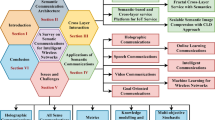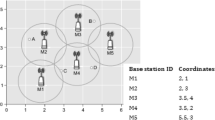Abstract
Quality of service (QoS) in wireless mesh networks is an active area of research, which is driven by the increasing demand for real-time and multimedia applications, such as Voice over IP and Video on Demand. In this paper, we propose a novel QoS based routing protocol for wireless mesh infrastructure, called Hybrid QoS Mesh Routing (HQMR). It is composed of two QoS based routing sub-protocols: a reactive multi-metric routing protocol for intra-infrastructure communications and a proactive multi-tree based routing protocol for communications with external networks. The proposed routing protocol enables forwarding real-time and streaming applications with QoS guarantee in a mesh wireless environment, by assigning a specific routing path for each defined service class. To this end, three different QoS service classes are defined, depending on the applications requirements. We analyze in this paper the simulation results of different scenarios conducted on the network simulator ns-3 to demonstrate the effectiveness of the HQMR protocol and to compare it to other routing protocols while forwarding real-time applications with QoS guarantee.


















Similar content being viewed by others
References
Akyildiz, I. F., & Wang, X. (2005). A survey on wireless mesh networks. IEEE Communications Magazine, 43(9), S23–S30.
Akyildiz, I. F., Wang, X., & Wang, W. (2005). Wireless mesh networks: A survey. Computer Networks, 47(4), 445–487.
Acampora, G., Gaeta, M., Loia, V., & Vasilakos, A. V. (2010). Interoperable and adaptive fuzzy services for ambient intelligence applications. ACM Transactions on Autonomous and Adaptive Systems, 5(2), 8:1–8:26.
Attar, A., Tang, H., Vasilakos, A. V., Yu, F. R., & Leung, V. C. M. (2012). A survey of security challenges in cognitive radio networks: Solutions and future research directions. Proceedings of the IEEE, 100(12), 3172–3186.
Wang, X., Vasilakos, A. V., Chen, M., Liu, Y., & Kwon, T. T. (2011). A survey of green mobile networks: Opportunities and challenges. Mobile Networks and Applications, 17(1), 4–20.
Zeng, Y., Xiang, K., Li, D., & Vasilakos, A. V. (2012). Directional routing and scheduling for green vehicular delay tolerant networks. Wireless Networks, 19(2), 161–173.
Liu, Y., Xiong, N., Zhao, Y., Vasilakos, A. V., Gao, J., & Jia, Y. (2010). Multi-layer clustering routing algorithm for wireless vehicular sensor networks. IET Communications, 4(7), 810–816.
Duarte, P. B. F., Fadlullah, Z. M., Vasilakos, A. V., & Kato, N. (2012). On the partially overlapped channel assignment on wireless mesh network backbone: A game theoretic approach. IEEE Journal on Selected Areas in Communications, 30(1), 119–127.
Meng, T., Wu, F., Yang, Z., Chen, G., & Vasilakos, A. (2015). Spatial reusability-aware routing in multi-hop wireless networks. IEEE Transactions on Computing, PP(99), 1.
Li, P., Guo, S., Yu, S., & Vasilakos, A. V. (2012). CodePipe: An opportunistic feeding and routing protocol for reliable multicast with pipelined network coding. In Proceedings IEEE INFOCOM (pp. 100–108).
Yen, Y.-S., Chao, H.-C., Chang, R.-S., & Vasilakos, A. (2011). Flooding-limited and multi-constrained QoS multicast routing based on the genetic algorithm for MANETs. Mathematical and Computer Modelling, 53(11–12), 2238–2250.
Li, P., Guo, S., Yu, S., & Vasilakos, A. V. (2014). Reliable multicast with pipelined network coding using opportunistic feeding and routing. IEEE Transactions on Parallel and Distributed Systems, 25(12), 3264–3273.
Youssef, M., Ibrahim, M., Abdelatif, M., Chen, L., & Vasilakos, A. V. (2014). Routing metrics of cognitive radio networks: A survey. IEEE Communications Surveys & Tutorials, 16(1), 92–109.
Marwaha, S., Srinivasan, D., Tham, C. K., & Vasilakos, A. (2004). Evolutionary fuzzy multi-objective routing for wireless mobile ad hoc networks. In Congress on evolutionary computation, CEC’04 (Vol. 2, pp. 1964–1971).
Zhang, X. M., Zhang, Y., Yan, F., & Vasilakos, A. V. (2015). Interference-based topology control algorithm for delay-constrained mobile ad hoc networks. IEEE Transactions on Mobile Computing, 14(4), 742–754.
“Ad hoc On-Demand Distance Vector Routing (AODV).” [Online]. http://www.ietf.org/rfc/rfc3561.txt. Accessed September 22, 2015.
“Optimized Link State Routing (OLSR).” [Online]. http://www.ietf.org/rfc/rfc3626.txt. Accessed September 22, 2015.
“The Dynamic Source Routing Protocol (DSR).” [Online]. http://www.ietf.org/rfc/rfc4728.txt. Accessed September 22, 2015.
Woungang, I., Dhurandher, S. K., Anpalagan, A., & Vasilakos, A. V. (Eds.). (2013). Routing in opportunistic networks. New York: Springer.
Yao, Y., Cao, Q., & Vasilakos, A. V. (2013). EDAL: An energy-efficient, delay-aware, and lifetime-balancing data collection protocol for wireless sensor networks. In IEEE 10th international conference on mobile ad-hoc and sensor systems (MASS) (pp. 182–190).
Song, Y., Liu, L., Ma, H., & Vasilakos, A. V. (2014). A biology-based algorithm to minimal exposure problem of wireless sensor networks. IEEE Transactions on Network and Service Management, 11(3), 417–430.
Liu, L., Song, Y., Zhang, H., Ma, H., & Vasilakos, A. V. (2015). Physarum optimization: A biology-inspired algorithm for the steiner tree problem in networks. IEEE Transactions on Computers, 64(3), 818–831.
Vasilakos, A. V., Zhang, Y., & Spyropoulos, T. (2011). Delay tolerant networks: Protocols and applications (1st ed.). Boca Raton, FL: CRC Press Inc.
Dvir, A., & Vasilakos, A. V. (2010). Backpressure-based routing protocol for DTNs. In Proceedings of the ACM SIGCOMM conference, New York, NY, USA (pp. 405–406).
Spyropoulos, T., Rais, R. N. B., Turletti, T., Obraczka, K., & Vasilakos, A. (2010). Routing for disruption tolerant networks: Taxonomy and design. Wireless Networks, 16(8), 2349–2370.
Xue, Q., & Ganz, A. (2002). QoS routing for mesh-based wireless LANs. International Journal of Wireless Information Networks, 9(3), 179–190.
Xue, Q., & Ganz, A. (2003). Ad hoc QoS on-demand routing (AQOR) in mobile ad hoc networks. Journal of Parallel and Distributed Computing, 63(2), 154–165.
Draves, R., Padhye, J., & Zill, B. (2004). Comparison of routing metrics for static multi-hop wireless networks. New York, NY (pp. 133–144).
Kone, V., Das, S., Zhao, B. Y., & Zheng, H. (2007). QUORUM: Quality of service in wireless mesh networks. Mobile Networks and Applications, 12(5), 358–369.
Pal, A., & Nasipuri, A. (2011). A quality based routing protocol for wireless mesh networks. Pervasive and Mobile Computing, 7(5), 611–626.
Liu, L., Zhu, L., Lin, L., & Wu, Q. (2012). Improvement of AODV routing protocol with QoS support in wireless mesh networks. Physics Procedia, 25, 1133–1140.
Zhang, Y., Wei, Y., Song, M., & Song, J. (2006). R-AODV: Rate aware routing protocol for WiFi mesh networks. In IET International Conference on Wireless, Mobile and Multimedia Networks (pp. 1–4).
Cheng, X., Mohapatra, P., Lee, S.-J., & Banerjee, S. (2008). MARIA: Interference-aware admission control and QoS routing in wireless mesh networks. In IEEE international conference on communications, ICC’08 (pp. 2865–2870).
Malgi, M. A., & Gaikwad, G. N. (2015). A study on QoS enhancement of MPEG-4 video transmission over wireless mesh network. In International conference on pervasive computing (ICPC) (pp. 1–5).
Zhou, L., Xiong, N., Shu, L., Vasilakos, A., & Yeo, S.-S. (2010). Context-aware middleware for multimedia services in heterogeneous networks. IEEE Intelligent Systems, 25(2), 40–47.
Yun, J., Han, J., Seong, G., Cho, W., Seo, J., Khan, M., Kim, B., Park, G., & Han, K. (2014). Self-organized multi-metric routing for QoS in wireless mesh networks. In International conference on information networking (ICOIN) (pp. 160–163).
Lu, Q., Ma, Y., & Zhang, J. (2009). A study of the active router structure. In International colloquium on computing, communication, control, and management, CCCM’09 (Vol. 1, pp. 157–160).
IEEE Standard for Information Technology–Telecommunications and information exchange between systems–Local and metropolitan area networks–Specific requirements Part 11: Wireless LAN Medium Access Control (MAC) and Physical Layer (PHY) specifications Amendment 10: Mesh Networking. (2011). (pp. 1–372).
IEEE Standard for Information technology–Telecommunications and information exchange between systems Local and metropolitan area networks–Specific requirements Part 11: Wireless LAN Medium Access Control (MAC) and Physical Layer (PHY) Specifications. (2012). IEEE Std 80211-2012 (pp. 1–2793).
Ueda, K., & Baba, K.-I. (2009). Proposal of an initial route establishment method in wireless mesh networks. In Annual international symposium on applications and the internet, SAINT’09 (pp. 173–176).
Maurina, S., Riggio, R., Rasheed, T., & Granelli, F. (2009). On tree-based routing in multi-gateway association based wireless mesh networks. In IEEE 20th international symposium on personal, indoor and mobile radio communications (pp. 1542–1546).
Wenjiang, J. , Jianfeng, M., Zhuo, M., & Youliang, T. (2012). Tree-based proactive routing protocol for wireless mesh network. China Communications, 9(1), 25–33.
Madhusudan, S., Lee, S.-G., & Lee, H. J. (2013). Non-root-based hybrid wireless mesh protocol for wireless mesh networks. International Journal of Smart Home, 7(2), 71–84.
Bargaoui, H., Mbarek, N., Togni, O., & Frikha, M. (2014). Hybrid QoS based routing for IEEE 802.16j mesh infrastructure. In The Tenth advanced international conference on telecommunications (pp. 110–118).
Ad hoc On-Demand Distance Vector Routing (AODV). [Online]. http://www.ietf.org/rfc/rfc3561.txt. Accessed September 22, 2015.
ns-3. [Online]. http://www.nsnam.org/. Accessed September 22, 2015.
Acknowledgments
This work has been funded by the regional Council of Burgundy, France.
Author information
Authors and Affiliations
Corresponding author
Rights and permissions
About this article
Cite this article
Bargaoui, H., Mbarek, N., Togni, O. et al. Hybrid QoS based routing protocol for inter and intra wireless mesh infrastructure communications. Wireless Netw 22, 2111–2130 (2016). https://doi.org/10.1007/s11276-015-1091-0
Published:
Issue Date:
DOI: https://doi.org/10.1007/s11276-015-1091-0




